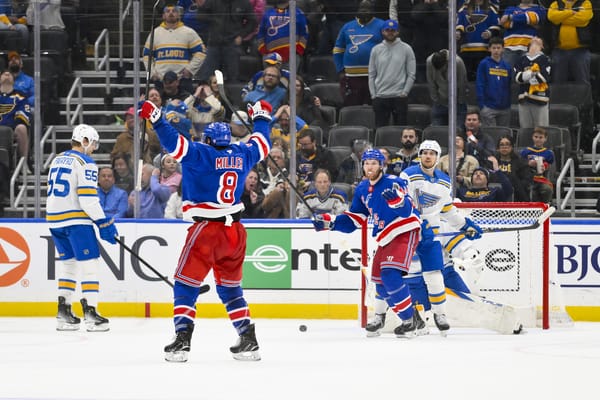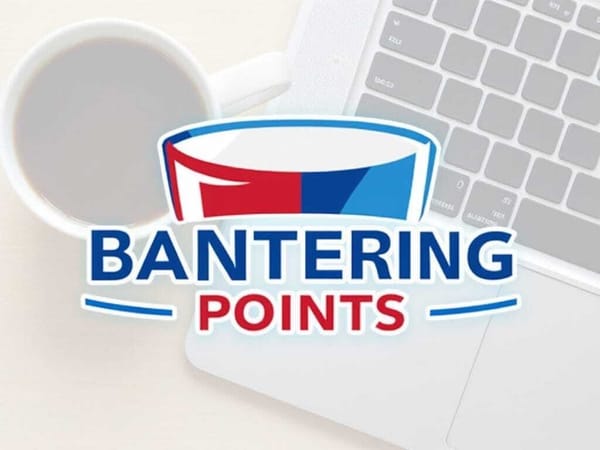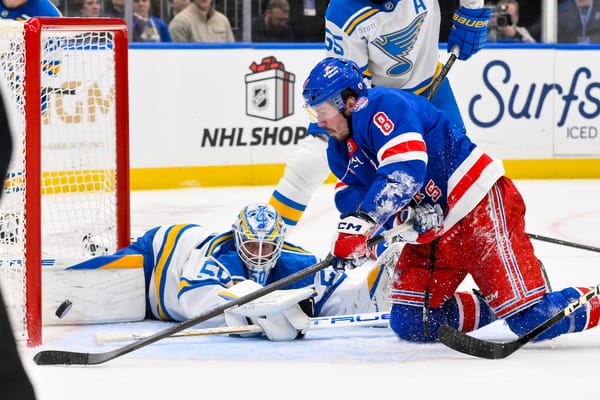Filip Chytil Is A Key Part of The Future And Should Be Playing in Rangers’ Top Six
The Rangers have decisions looming, and Chytil’s long term potential to succeed Zibanejad is an important one on the list.
Heads turned when Filip Chytil started the season with the Hartford Wolf Pack, but the assignment seemed to have the intended result; the young center tallied nine points in nine games and had a jump in his step once promoted to the NHL level.
The Rangers’ No. 21 overall pick in 2017 stepped up big time when Mika Zibanejad was sidelined with an upper body injury. In the month without their leading center, Chytil posted a line of 7-2-9 in 13 games while skating 16:50 a night.
Between October 29 and November 27 Chytil also boasted a slash line which featured a 66.67 GF%, a 51.11 CF%, and an xGF% of 57.10. It was exactly what the Rangers needed at the time.
But when Zibanejad returned, the lines changed which influenced Chytil’s role in the lineup.
When his play began to fade, so did his time as the second line center, with Strome and Zibanejad slotting ahead of him. Overall, since Zibanejad returned to the lineup, Chytil’s appeared in 25 games and has a line of 4-4-8 while skating just 14:41 a night. His slash line also includes a 51.85 GF%, a 46.39 CF%, and a 45.32 xGF%.
It’s clear that he hasn’t been as productive lately, so let’s take a closer look.
A good place to start is looking at how Chytil’s been utilized this season to see if there’s a trend or situation that explains his decline in play, while also offering a solution to get him back to where he was before.
According to Left Wing Lock, the Rangers’ most frequent lines this year have been:
- (1) Artemiy Panarin — Ryan Strome — Jesper Fast (10.1%)
- (2) Chris Kreider — Mika Zibanejad — Pavel Buchnevich (7.6%)
- (3) Brendan Lemieux — Brett Howden — Kaapo Kakko (5.3%)
- (4) Chris Kreider — Filip Chytil — Pavel Buchnevich (5.1%)
- (5) Brett Howden — Filip Chytil — Kaapo Kakko (3.9%)
- (6) Artemiy Panarin — Ryan Strome — Pavel Buchnevich (3.7%)
- (7) Artemiy Panarin — Mika Zibanejad — Pavel Buchnevich (3.1%)
- (8) Artemiy Panarin— Ryan Strome — Kaapo Kakko (2.3%)
- (9) Chris Kreider — Mika Zibanejad — Jesper Fast (2.1%)
- (10) Artemiy Panarin — Ryan Strome — Chris Kreider (2.1%)/
Chytil’s been part of the Rangers’ fourth and fifth most frequent lines, so that’s where we’ll start. Chytil got his chance down the middle of the second line when Zibanejad was injured vs. the Boston Bruins. In that time, the KCB line has spent 110:28 together at 5v5. In that time, the line posted a 56.1 CF%, a 70.00 GF%, and an xGF% of 62.25.
According to Money Puck, the line has been the seventh-best offensive line in the league, and here’s some lines ahead of them. Context is key when looking at any of these numbers, but the takeaway is that the Rangers drove play with them on the ice.
At the very least Chytil and Buchnevich should be reunited, because their chemistry together really helped drive the line. The duo has spent 81:43 together this season, and in that span has a line that includes a 53.22 CF%, a 62.50 GF%, and an xGF% of 54.30.
Of the 17 goals Chytil’s been involved in, six of them have included Buchnevich picking up a point on the same play.
Chytil hasn’t had the same overall success with just Kreider, and in 63:22 together the duo has posted a line that includes a 46.02 CF%, a 87.50 GF%, and an xGF% of 45.06. Here the actual goals for stands out, although there’s been just one situation in which Kreider and Chytil picked up a point on the same goal, and the other metrics lag. But of course, the third part of that trio always has to be a consideration as well, this is just one piece of the puzzle.
Lastly, Buchnevich and Kreider has spent a fair bit of time together away from Chytil — 182:13 5v5 to be exact — and their line features a 49.85 CF%, a 43.75 GF%, and an xGF% of 51.18. Of note here is a low actual GF%, and it’s worth noting both have picked up points on the same goal only four times this year.
Here’s the above represented in visual form:
The long story short here is;
- Buchnevich and Chytil have been a very effective combo (black arrow)
- Kreider and Chytil have been an OK combo (black arrow)
- Buchnevich has held his own away from Chytil (red arrow)
- Chytil has lagged without Buchnevich (blue arrow)
- Chytil has been decent without Kreider (blue arrow)
- Kreider hasn’t been great away from Chytil (red arrow)/
A small disclaimer here is that I understand the concept of WOWYs not telling the complete story because they don’t factor in a third linemate or competition, but I think it is an interesting element to point out in context of everything else. In some cases the impact is very apparent, and we’ll see that in just a bit.
Another way of looking at it would be looking at each player’s individual impact this year, and for that well look at their individual RAPM charts side by side from Evolving-Hockey.
Here we can see Chytil and Buchnevich individually have had strong seasons, whereas Kreider’s hasn’t been the player he’s been in recent years. His play has improved over the last month, but overall it is a decline from his prime years.
The second line to look at is the kid line — whose moniker the diaper line has picked up steam — although in my view it makes sense in an unintended way because their results thus far have been crappy. The unit has been together for 83:43 of 5v5 ice time, and has a collective line that features a 46.63 CF%, a 25.00 GF%, and an xGF% of 40.02.
Chytil spent 51:31 together with Kakko prior to Howden joining the line, and in that span they’ve posted a 36.45 CF%, a 0.00 GF%, and an xGF% of 30.03. Lastly, Chytil has also spent 33:10 together with Howden away from Kakko, and their results include a 49.18 CF%, a GF% of 100 (two for, and 0 against), and an xGF% of 61.03.
Once again, here’s the above in a more visual form:
The long story short here is:
- Kakko and Howden have really benefited from being with Chytil (red arrow vs. black arrow)
- Chytil has been noticeably better away from Kakko (blue arrow)
- Chytil with Howden has led to more shots for and against (black arrow) vs. Chytil away from Howden (blue arrow)/
And once again here’s each player’s individual RAPM chart side by side.
Both Howden and Kakko have struggled, and if the circumstances were different the Rangers probably could assign them to Hartford to marinate. The Pack are a strong team this year, and both would benefit from gaining some playoff experience.
As for the line, I understand what the intention was here, but not sure it make sense to limit Chytil’s 5v5 ice time, deploy him with someone learning a new position, and one of the youngest players in the league who has struggled with adjusting to the NHL. Chytil himself is a work in progress, and it would be beneficial to have him in a situation where his own development can continue, and not be stunted. The line overall hasn’t been together very long — although it is the Rangers’s fifth most frequent line —so I don’t want to rule out potential improvement, but I’m not sure we are going to see it.
Given all this information, what should the Rangers do forward?
The answer isn’t a simple one, because given the team’s spot in the standings there’s a chance some players could be sold off at the deadline, and there’s an equal chance the team will go far as they can in an attempt of making the playoffs. Either scenario directly involves players such as Kreider, Strome, and Fast upfront. Strome is an RFA so a decision regarding him isn’t as timely, but there’s the chance the club sells super high on him.
Is Ryan Strome playing some of the best hockey of his NHL career? Yes.
— Rob Luker (@RLuker12) January 21, 2020
Is Ryan Strome also benefiting from playing with an MVP candidate in Panarin? Also yes.
I'm wary of the effects/results lasting multiple years is all.https://t.co/o7RGkZTUEC pic.twitter.com/BkthT26kjX
If you were to throw that concept out and just look at maximizing results in the top six, the Rangers lines should look like this:
- Panarin — Zibanejad/Chytil — Kakko
- Kreider — Chytil/Zibanejad — Buchnevich
- Howden — Strome — Fast
- Lemieux — McKegg — Smith/
I think there’s something to be said about giving Kakko more of a look with two players who drive play like Panarin and Zibanejad to see if he can get some chances to build his confidence. That would reunite the KCB line which has been successful this year. I also think there’s value in reunited the KZB line, and seeing how Chytil meshes long term with Panarin. Panarin and Zibanejad are two of the team’s most dynamic players, so I can understand the logic of keeping them off the same line.
More importantly, I think there’s value in seeing if Strome can be productive away from Panarin, and this situation would at least keep him with Fast; someone he’s spent a lot of time with this season. The Rangers would be foolish to invest a lot in a player who can’t run their own line, especially one who should ultimately be passed on the depth chart by Chytil. Passing has been a big element of Strome’s game, and having a right-handed shot feeding pucks to a left-handed winger like Kakko could be something worth investigating.
Last is a fourth line which won’t play a whole lot, so there isn’t as much issue with its overall construction. This is something that will need to be addressed going forward, but for now it remains as is.
But realistically it’s unlikely that two top six players will be relegated to the bottom six, so therefore I’d expect lines to look a little more like this
- Panarin — Zibanejad — Fast
- Kreider — Chytil — Buchnevich
- Howden/Lemieux — Strome — Kakko
- Lemieux/Howden — McKegg — Smith/
Overall, Chytil is a dynamic offensive player the Rangers should be learning more about, because it is possible he’s the No. 1 center of the future. In terms of shot rates, Chytil (red) had been in the same quadrant — fun — as Panarin (blue) which is good to see.
His overall readiness and ability to fill that role could ultimately play a role in future negotiations with Zibanejad in terms of how many years the Rangers offer him. Conversely, he may not be that guy, and if Chytil’s ability is that of only a No. 2 center, the Rangers would be wise to start drafting other centers with top line talent to eventually take over for Zibanejad down the line. Center isn’t a particularly deep area of the prospect pool, with the two players of note being Karl Henriksson (No. 58 overall, 2019), and Morgan Barron (No. 174 overall, 2017).
Right now the Rangers aren’t doing that with him on the third line, and Strome in the top six, and delaying the evaluation period of Chytil in more of a high leverage role doesn’t make sense. It has less to do with Strome’s performance and more to do with Chytil’s growth, even with his his chemistry with Panarin in mind.
In a way this is similar to how the Rangers handled Alexandar Georgiev last year in a non contending season by only giving him 30 starts, but now this year given his impending RFA status, and the balancing of Igor Shesterkin, he’s made 21 starts in the first half.
Ideally the Rangers will head into 2020-21 with an idea of what Chytil is, and potentially become over another 82 game season, as his ELC will expire on July 1, 2021. In a perfect world the Rangers would have a pretty good idea of his abilities, and be in a position to try and save some money by offering him a lengthy second contract.
In recent years the Rangers have lived and died with bridge contracts when it comes to forwards, and that has prevented them from locking up key pieces at under market value long term.
Future contract and money aside, in order to help further his development and start assessing for the future, they should give him some more playing time in the top six. If for nothing else to see how he handles the increased playing time and competition over an extended period.
Stats via Natural Stat Trick unless otherwise noted.





